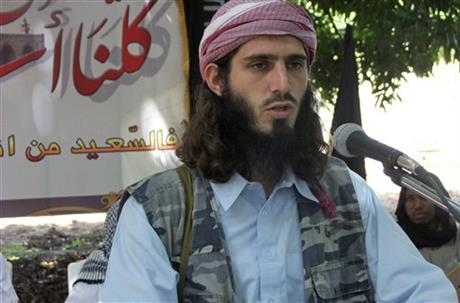
By ABDI GULED and JASON STRAZIUSO
FILE – In this Wednesday, May 11, 2011 file photo, American-born Islamist militant Omar Hammami addresses a press conference of the militant group al-Shabab at a farm in southern Mogadishu’s Afgoye district in Somalia. Hammami, a jihadi from Alabama whose nom de guerre is Abu Mansoor Al-Amriki, or “the American,” and ascended the ranks of Somalia’s al-Qaida-linked militant group al-Shabab high enough to attract a $5 million U.S. government bounty, was killed Thursday, Sept. 12, 2013 in an ambush ordered by the militant group’s leader, militants said. (AP Photo/Farah Abdi Warsameh, File)
MOGADISHU, Somalia (AP) — A rapping jihadi from Alabama who ascended the ranks of Somalia’s al-Qaida-linked extremist rebels and was on the FBI’s Most Wanted list with a $5 million reward for his capture was killed Thursday in an ambush ordered by the rebels’ leader, the militants said.
Omar Hammami, a native of Daphne, Alabama, who was known as Abu Mansoor Al-Amriki, or “the American,” died in southern Somalia following several months on the run after a falling-out with al-Shabab’s top leader, the rebels said.
Reports of Hammami’s death have cropped up every few months in Somalia, only for him to resurface a short while later. But a U.S. terrorism expert who closely follows the inner workings of the al-Shabab rebels says he thinks that the current reports of the death are accurate.
“I think it’s very likely true based on the sources I am seeing,” said J.M. Berger, who runs the website Intelwire.com.
The rebels did not immediately present proof of Hammami’s death.
A member of al-Shabab who gave his name as Sheik Abu Mohammed told The Associated Press that Hammami was killed in an ambush in Somalia’s southern Bay region. Some of Mohammed’s associates carried out the killing, he said. Two other fighters with Hammami, including a Briton of Somali descent, were also killed, he said.
Along with Adam Gadahn in Pakistan — a former Osama bin Laden spokesman — the 29-year-old Hammami is one of the two most notorious Americans in jihad groups. He grew up in Daphne, a community of 20,000 outside Mobile, the son of a Christian mother and a Syrian-born Muslim father.
His YouTube videos that featured him rapping and his presence on Twitter made him one of the most recognizable and studied U.S. foreign fighters. The U.S. put Hammami on its Most Wanted terrorist list in March and offered a $5 million reward for information leading to his capture.
U.S. prosecutors had charged Hammami with providing material support to terrorists.
In Alabama, Husam Omar, vice president of the Islamic Society in the city of Mobile, a mosque Hammami once attended, said he had not heard of the reports of his death.
“I’m shocked,” Omar said, declining further comment.
Hammami moved from Alabama to Somalia and joined al-Shabab in about 2006. He fought alongside al-Shabab for years until they had a falling out amid signs of increasing tension between Somali and foreign fighters in the group. He first expressed fear for his life in a web video in March 2012 that publicized his rift with al-Shabab.
The first serious attempt on his life was made in April.
“Just been shot in neck by shabab assassin. not critical yet,” Hammami tweeted after the April attack. He later wrote on Twitter that the leader of al-Shabab was sending in forces from multiple directions. “we are few but we might get back up. abu zubayr has gone mad. he’s starting a civil war,” Hammami posted.
Hammami accused al-Shabab’s leaders of living extravagant lifestyles with the taxes fighters collect from Somali residents. Another Hammami grievance is that the Somali militant leaders sideline foreign militants inside al-Shabab and are concerned only about fighting in Somalia, not globally.
The leader of al-Shabab, Mukhtar Abu Zubeyr, is also known as Godane.
Berger said that Hammami has been “a thorn in the side of al-Shabab” for more than two years and “one of the few surviving dissenters after Godane’s bloody purge over the summer.”
Before the falling out, Hammami made frequent appearances in al-Shabab combat videos, and in 2011 he released two rap songs, “Send Me a Cruise (missile)” and “Make Jihad With Me.”
Last December, al-Shabab slapped Hammami publicly in an Internet statement, saying his video releases are the result of personal grievances that stem from a “narcissistic pursuit of fame.”
Militants in Somalia have long hosted foreign fighters in the country. U.S. officials say that al-Shabab, which has been around since about 2006, counts several hundred foreign fighters among its ranks, including several dozen Somali-Americans from Minnesota.
Al-Shabab and al-Qaida announced formal merger in February 2012, but the Somali militant group maintained a reputation as being hostile to foreign fighters.
“Hammami brought a lot of unwelcome outside scrutiny on Shabab from the international jihadist community. His story will likely be a case study on what can go wrong when Westerners join jihadist movements,” Berger said.
Hammami gave infrequent interviews to Somlia-focused journalists. Last week the Voice of America interviewed the wanted American, who said he was unlikely to ever return to the United States “That is not an option unless it’s in a body bag,” Hammami said.
Frequent Twitter postings over the last year alluded to the fact that Hammami’s life was in danger. He had disavowed al-Shabab but in last week’s interviewed still classified himself as a terrorist.
“i’ll be a mujahid till the day i die whether it’s shabab who kills me or someone else,” Hammami wrote in an April Twitter posting.
___
Associated Press reporter Jay Reeves in Birmingham, Alabama contributed to this report. Straziuso reported from Nairobi, Kenya.



